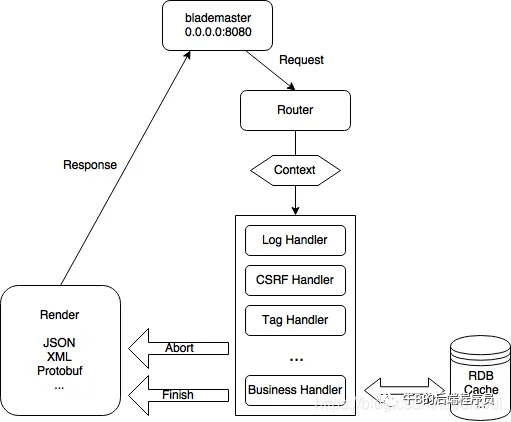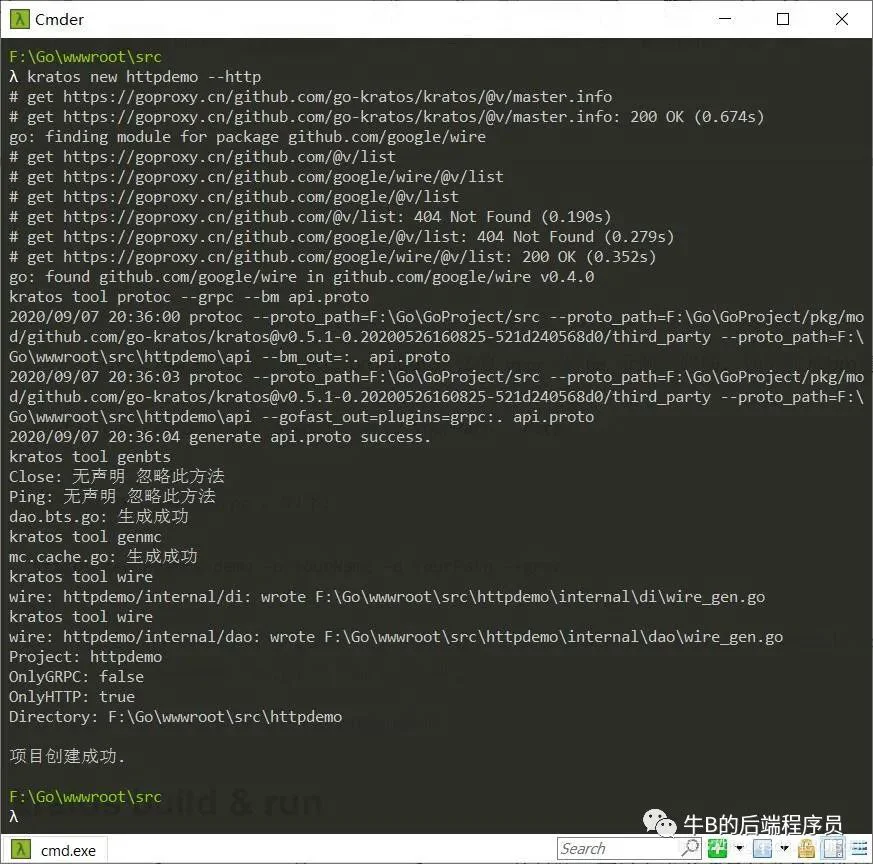背景
在像微服务这样的分布式架构中,经常会有一些需求需要你调用多个服务,但是还需要确保服务的安全性、统一化每次的 请求日志或者追踪用户完整的行为等等。
你可能需要一个框架来帮助你实现这些功能。比如说帮你在一些关键路径的请求上配置必要的鉴权 或超时策略。那样服务间的调用会被多层中间件所过滤并检查,确保整体服务的稳定性。
设计目标
性能优异,不应该掺杂太多业务逻辑的成分
方便开发使用,开发对接的成本应该尽可能地小
后续鉴权、认证等业务逻辑的模块应该可以通过业务模块的开发接入该框架内
默认配置已经是 production ready 的配置,减少开发与线上环境的差异性
kratos的http服务架构-blademaster
blademasterginRouterContextHandlerContextHandlersmiddlerwareHandlerblademaster
blademasterHandlerHandlerHandlerResponsemiddlewareRenderResponseJSONXMLRender快速开始
创建http项目:
kratos new httpdemo --http可以指定名字和目录:
kratos new kratos-demo -o YourName -d YourPath
创建项目成功后,进入 internal/server/http 目录下,默认生成的 server.go 模板:
package http
import (
"net/http"
pb "httpdemo/api"
"httpdemo/internal/model"
"github.com/go-kratos/kratos/pkg/conf/paladin"
"github.com/go-kratos/kratos/pkg/log"
bm "github.com/go-kratos/kratos/pkg/net/http/blademaster"
)
var svc pb.DemoServer
// New new a bm server.
func New(s pb.DemoServer) (engine *bm.Engine, err error) {
var (
cfg bm.ServerConfig
ct paladin.TOML
)
if err = paladin.Get("http.toml").Unmarshal(&ct); err != nil {
return
}
if err = ct.Get("Server").UnmarshalTOML(&cfg); err != nil {
return
}
svc = s
engine = bm.DefaultServer(&cfg)
pb.RegisterDemoBMServer(engine, s)
initRouter(engine)
err = engine.Start()
return
}
//路由
func initRouter(e *bm.Engine) {
e.Ping(ping) // engine自带的"/ping"接口,用于负载均衡检测服务健康状态
g := e.Group("/httpdemo") // // e.Group 创建一组 "/httpdemo" 起始的路由组
{
g.GET("/start", howToStart) // // g.GET 创建一个 "httpdemo/start" 的路由,使用GET方式请求,默认处理Handle r为howToStart方法
}
}
//engine自带Ping方法,用于设置 /ping 路由的handler,该路由统一提供于负载均衡服务做健康检测。服务是否健康,可自 定义 ping handler 进行逻辑判断,如检测DB是否正常等。
func ping(ctx *bm.Context) {
if _, err := svc.Ping(ctx, nil); err != nil {
log.Error("ping error(%v)", err)
ctx.AbortWithStatus(http.StatusServiceUnavailable)
}
}
// bm的handler方法.
func howToStart(c *bm.Context) {
k := &model.Kratos{
Hello: "Golang 大法好 !!!",
}
c.JSON(k, nil)
}默认路由
默认路由有:
/metrics 用于prometheus信息采集
/metadata 可以查看所有注册的路由信息
打开浏览器访问:
http://localhost:8000/metadata查看已注册路由信息
{
"code": 0,
"message": "0",
"ttl": 1,
"data": {
"/debug/pprof/": {
"method": "GET"
},
"/debug/pprof/allocs": {
"method": "GET"
},
"/debug/pprof/block": {
"method": "GET"
},
"/debug/pprof/cmdline": {
"method": "GET"
},
"/debug/pprof/goroutine": {
"method": "GET"
},
"/debug/pprof/heap": {
"method": "GET"
},
"/debug/pprof/mutex": {
"method": "GET"
},
"/debug/pprof/profile": {
"method": "GET"
},
"/debug/pprof/symbol": {
"method": "GET"
},
"/debug/pprof/threadcreate": {
"method": "GET"
},
"/debug/pprof/trace": {
"method": "GET"
},
"/demo.service.v1.Demo/Ping": {
"method": "GET"
},
"/demo.service.v1.Demo/SayHello": {
"method": "GET"
},
"/demo/say_hello": {
"method": "GET"
},
"/httpdemo/param1/:name": {
"method": "GET"
},
"/httpdemo/param2/:name/:gender/:say": {
"method": "GET"
},
"/httpdemo/param3/:name/*action": {
"method": "GET"
},
"/httpdemo/start": {
"method": "GET"
},
"/metadata": {
"method": "GET"
},
"/metrics": {
"method": "GET"
},
"/ping": {
"method": "GET"
}
}
}路径参数
我们在路由中增加一些内容,增加一个handler方法showParam:
func initRouter(e *bm.Engine) {
e.Ping(ping)
g := e.Group("/httpdemo")
{
g.GET("/start", howToStart)
// 路径参数有两个特殊符号":"和"*"
// ":" 跟在"/"后面为参数的key,匹配两个/中间的值 或 一个/到结尾(其中不再包含/)的值
// "*" 跟在"/"后面为参数的key,匹配从 /*开始到结尾的所有值,所有*必须写在最后且无法多个
// NOTE:这是不被允许的,会和 /start 冲突
// g.GET("/:xxx")
// NOTE: 可以拿到一个key为name的参数。注意只能匹配到/param1/soul,无法匹配/param1/soul/hao(该路径会404)
g.GET("/param1/:name", showParam)
// NOTE: 可以拿到多个key参数。注意只能匹配到/param2/soul/male/hello,无法匹配/param2/soul或/param2/soul/hello
g.GET("/param2/:name/:gender/:say", showParam)
// NOTE: 可以拿到一个key为name的参数 和 一个key为action的路径。
// NOTE: 如/params3/soul/hello,action的值为"/hello"
// NOTE: 如/params3/soul/hello/hi,action的值为"/hello/hi"
// NOTE: 如/params3/soul/hello/hi/,action的值为"/hello/hi/"
g.GET("/param3/:name/*action", showParam)
}
}
func showParam(c *bm.Context) {
name, _ := c.Params.Get("name")
gender, _ := c.Params.Get("gender")
say, _ := c.Params.Get("say")
action, _ := c.Params.Get("action")
path := c.RoutePath // NOTE: 获取注册的路由原始地址,如: /httpdemo/param1/:name
c.JSONMap(map[string]interface{}{
"name": name,
"gender": gender,
"say": say,
"action": action,
"path": path,
}, nil)
}
打开浏览器访问:
http://localhost:8000/httpdemo/param2/Soul/male/hello输出内容:
{
"action": "",
"code": 0,
"gender": "male",
"message": "0",
"name": "Soul",
"path": "/httpdemo/param2/:name/:gender/:say",
"say": "hello"
}Context
blademasterContext// Context is the most important part. It allows us to pass variables between
// middleware, manage the flow, validate the JSON of a request and render a
// JSON response for example.
type Context struct {
context.Context //嵌入一个标准库中的 Context实例,对应bm中的 Context,也是通过该实例来实现标准库中的 Context 接口
Request *http.Request //获取当前请求信息
Writer http.ResponseWriter //输出响应请求信息
// flow control
index int8 //标记当前正在执行的 handler 的索引位
handlers []HandlerFunc //中存储了当前请求需要执行的所有 handler
// Keys is a key/value pair exclusively for the context of each request.
Keys map[string]interface{} //在 handler 之间传递一些额外的信息
Error error //存储整个请求处理过程中的错误
method string //检查当前请求的 Method 是否与预定义的相匹配
engine *Engine //指向当前 blademaster 的 Engine 实例
}blademasterContextContextContextcontext deadline exceededRequestWriterhandlerindexKeyshandlerErrormethodMethodengineblademasterContext// 用于 Handler 的流程控制
func (c *Context) Abort()
func (c *Context) AbortWithStatus(code int)
func (c *Context) Bytes(code int, contentType string, data ...[]byte)
func (c *Context) IsAborted() bool
func (c *Context) Next()
// 用户获取或者传递请求的额外信息
func (c *Context) RemoteIP() (cip string)
func (c *Context) Set(key string, value interface{})
func (c *Context) Get(key string) (value interface{}, exists bool)
// 用于校验请求的 payload
func (c *Context) Bind(obj interface{}) error
func (c *Context) BindWith(obj interface{}, b binding.Binding) error
// 用于输出响应
func (c *Context) Render(code int, r render.Render)
func (c *Context) Redirect(code int, location string)
func (c *Context) Status(code int)
func (c *Context) String(code int, format string, values ...interface{})
func (c *Context) XML(data interface{}, err error)
func (c *Context) JSON(data interface{}, err error)
func (c *Context) JSONMap(data map[string]interface{}, err error)
func (c *Context) Protobuf(data proto.Message, err error)所有方法基本上可以分为三类:
流程控制
额外信息传递
请求处理
响应处理
Handler
blademasterHandlerbmHandlerRoutermiddlewareHandlerContexthandlersindex0Next()middlewareAbort()middlewareHandlerHandlerNext()Next()性能分析
2333pprofgo tool pprof http://127.0.0.1:8000/debug/pprof/profile-http.perf=tcp://0.0.0.0:12333